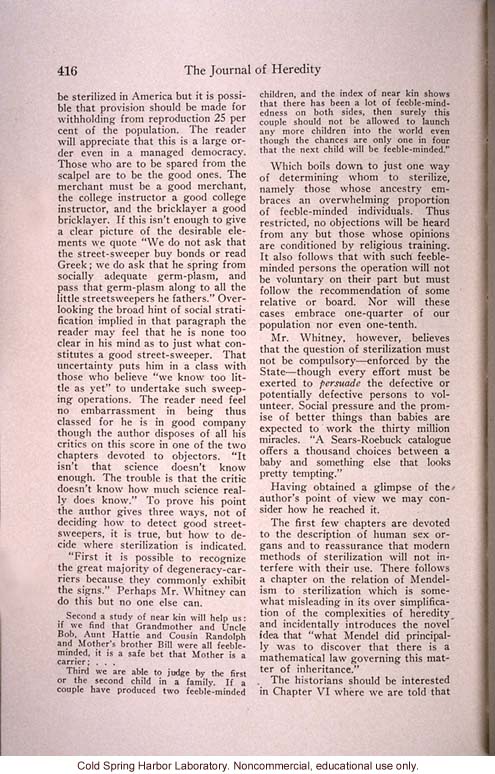416 The Journal of Heredity
be sterilized in America but it is possible that provision should be made for withholding from reproduction 25 per cent of the population. The reader will appreciate that this is a large order even in a managed democracy. Those who are to be spared from the scalpel are to be the good ones. The merchant must be a good merchant, the college instructor a good college instructor, and the bricklayer a good bricklayer. If this isn't enough to give a clear picture of the desirable elements we quote "We do not ask that the street-sweeper buy bonds or read Greek; we do ask that he spring from socially adequate germ-plasm, and pass that germ-plasm along to all the little streetsweepers he fathers." Overlooking the broad hint of social stratification implied in that paragraph the reader may feel that he in none too clear in his mind as to just what constitutes a good street-sweeper. That uncertainty puts him in a class with those who believe "we know too little as yet" to undertake such sweeping operations. The reader need feel no embarrassment in being thus classed for he is in good company though the author disposes of all his critics on this score in one of the two chapters devoted to objectors. "It isn't that science doesn't know enough. The trouble is that the critic doesn't know how much science really does know." To prove his point the author gives three ways, not of deciding how to detect good street-sweepers, it is true, but how to decide where sterilization is indicated.
"First it is possible to recognize the great majority of degeneracy-carriers because they commonly exhibit the signs." Perhaps Mr. Whitney can do this but no one else can.
Second a study of near kin will help us: if we find that Grandmother and Uncle Bob, Aunt Hattie and Cousin Randolph and Mother's brother Bill were all feeble-minded, it is a safe bet that Mother is a carrier; . . .
Third we are able to judge by the first of the second child in a family. If a couple have produced two feeble-minded children, and the index of near kin shows that there has been a lot of feeble-mindedness on both sides, then surely this couple should not be allowed to launch any more children into the world even though the chances are only one in four that the next child will be feeble-minded."
Which boils down to just one way of determining whom to sterilize, namely those whose ancestry embraces an overwhelming proportion of feeble-minded persons the operation will not be voluntary on their part but must follow the recommendation of some relative or board. Nor will these cases embrace one-quarter of our population nor even one-tenth.
Mr. Whitney, however, believes that the question of sterilization must not be compulsory--enforced by the State--though every effort must be exerted to [italics] persuade [end italics] the defective or potentially defective persons to volunteer. Social pressure and the promise of better things than babies are expected to work the thirty million miracles. "A Sears-Roebuck catalogue offers a thousand choices between a baby and something else that looks pretty tempting."
Having obtained a glimpse of the author's point of view we may consider how he reached it.
The first few chapters are devoted to the description of human sex organs and to reassurance that modern methods of sterilization will not interfere with their use. There follows a chapter on the relation of Mendelism to sterilization which is somewhat misleading in its over simplification of the complexities of heredity and incidentally introduces the novel idea that "what Mendel did principally was to discover that there is a mathematical law governing this matter of inheritance."
The historians should be interested in Chapter VI where we are told that


